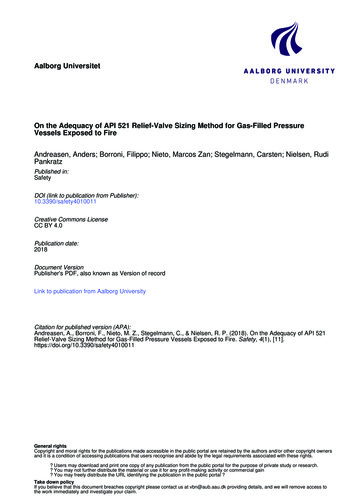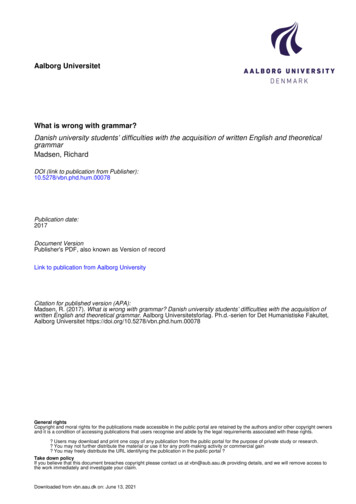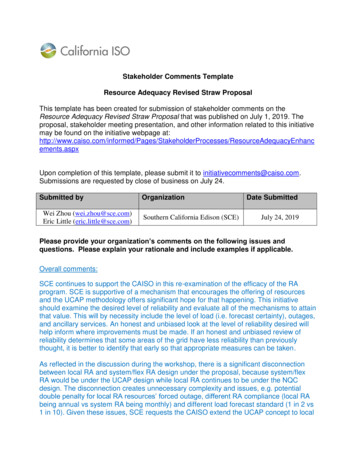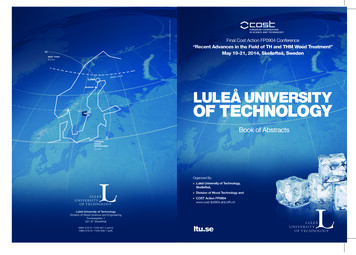
Transcription
Aalborg UniversitetOn the Adequacy of API 521 Relief-Valve Sizing Method for Gas-Filled PressureVessels Exposed to FireAndreasen, Anders; Borroni, Filippo; Nieto, Marcos Zan; Stegelmann, Carsten; Nielsen, RudiPankratzPublished in:SafetyDOI (link to publication from Publisher):10.3390/safety4010011Creative Commons LicenseCC BY 4.0Publication date:2018Document VersionPublisher's PDF, also known as Version of recordLink to publication from Aalborg UniversityCitation for published version (APA):Andreasen, A., Borroni, F., Nieto, M. Z., Stegelmann, C., & Nielsen, R. P. (2018). On the Adequacy of API 521Relief-Valve Sizing Method for Gas-Filled Pressure Vessels Exposed to Fire. Safety, 4(1), [11].https://doi.org/10.3390/safety4010011General rightsCopyright and moral rights for the publications made accessible in the public portal are retained by the authors and/or other copyright ownersand it is a condition of accessing publications that users recognise and abide by the legal requirements associated with these rights.? Users may download and print one copy of any publication from the public portal for the purpose of private study or research.? You may not further distribute the material or use it for any profit-making activity or commercial gain? You may freely distribute the URL identifying the publication in the public portal ?Take down policyIf you believe that this document breaches copyright please contact us at vbn@aub.aau.dk providing details, and we will remove access tothe work immediately and investigate your claim.
safetyArticleOn the Adequacy of API 521 Relief-Valve SizingMethod for Gas-Filled Pressure Vessels Exposedto FireAnders Andreasen 1, *Rudi P. Nielsen 2 ID12*ID, Filippo Borroni 2ID, Marcos Zan Nieto 2 , Carsten Stegelmann 1 andProcess and Technical Safety, Ramboll Energy, Bavnehøjvej 5, 6700 Esbjerg, Denmark; cts@ramboll.comDepartment of Chemistry and Bioscience, Aalborg University Esbjerg, Niels Bohrs Vej 8A, 6700 Esbjerg,Denmark; fborro16@student.aau.dk (F.B.); mzanni16@student.aau.dk (M.Z.N.); rudi@bio.aau.dk (R.P.N.)Correspondence: anra@ramboll.com; Tel.: 45-51616000Received: 22 December 2017; Accepted: 14 March 2018; Published: 19 March 2018Abstract: In this paper, the adequacy of the legacy API 521 guidance on pressure relief valve (PRV)sizing for gas-filled vessels subjected to external fire is investigated. Multiple studies show that inmany cases, the installation of a PRV offers little or no protection—therefore provides an unfoundedsense of security. Often the vessel wall will be weakened by high temperatures, before the PRVrelieving pressure is reached. In this article, a multiparameter study has been performed takinginto consideration various vessel sizes, design pressures (implicitly vessel wall thickness), vesseloperating pressure, fire type (pool fire or jet fire) by applying the methodology presented in theScandpower guideline. A transient thermomechanical response analysis has been carried out toaccurately determine vessel rupture times. It is demonstrated that only vessels with relatively thickwalls, as a result of high design pressures, benefit from the presence of a PRV, while for most cases noappreciable increase in the vessel survival time beyond the onset of relief is observed. For most of thecases studied, vessel rupture will occur before the relieving pressure of the PRV is reached.Keywords: jet fire; pressure relief valve (PRV); vessel rupture; fire heat load; pool fire1. IntroductionIn order to protect pressure vessels against overpressure in case of a fire scenario, a pressurerelief valve (PRV/PSV) is usually installed as a secondary barrier to protect against vessel rupture,further escalation and potential catastrophic events. The installation of a fire PRVin both upstream anddownstream industries is according to codes, standards, recommendations and best practices [1–3].When a gas-filled vessel is subject to an external fire, the vessel material heats up. Part of the heatis transferred to the gas inventory. When the inventory is heated up, the gas expands, and the pressureincreases. At some point, the pressure reaches the set pressure of the pressure relieving valve, and itwill open. If properly sized, the relief valve will protect against further increases in pressure.The API standard 521 provides guidance for the sizing of a PRV for a gas-filled vessel [3].The sizing equation is very simple and assumes the release rate is at its maximum, when the vessel wallmaterial has reached its maximum temperature (assumed to be 595 C for carbon steel), and the gas isat its relieving temperature, i.e., this is assumed to be the governing driving force for the heat transfer.The adequacy of the API sizing equation has been questioned in a number of references [4–6].API 521 itself highlights some potential issues with the sizing methods and recommends that morerigorous methods should be applied, if the underlying assumptions are not applicable.Safety 2018, 4, 11; ty
Safety 2018, 4, 112 of 17Due to poor heat transfer between the vessel inner wall and the gas inventory, the vessel materialwill heat up relatively more than the gas. At some point, the vessel wall temperature has increased to apoint, where it is weakened below the rupture stress limit.Wong [6] has addressed this issue and argues that this will occur before the internal gas pressurereaches the set pressure of the PRV due to local hot spots. No proof of the points made is providedother than arguments. Heitner et al. [5] has performed transient analysis of a gas-filled vesselthermomechanical response when subjected to fire heat loads from a pool fire. Their chosen exampleshowed that relieving conditions are reached after 6 min and that vessel failure will occur between19–27 min depending on the chosen relief valve size and material properties. Their results show thatin using the API 521 sizing method, the relief valve will be grossly oversized. They also compare theheat load implicitly assumed by the API 521 sizing for a gas-filled vessel with that of a liquid-filledvessel with the same heat transfer area. The API sizing for a liquid-filled vessel (where the relief isvapor generated by evaporation of the liquid phase) scales the total heat transfer rate with the surfacearea raised to the power of 0.82. The authors notice that proper sizing of a relief valve for a gas-filledvessel using transient analysis results in an effective heat transfer rate comparable to using the samearea scaling as for a liquid-filled vessel. The authors state this may be a coincidence.Nylund [4] has also carried out a transient analysis of the thermomechanical response of agas-filled vessel subjected to a fire heat load. Nylund investigates both the effect of local heat loadsdue to different sizes of impinging jet fires as well as the full engulfment of a pool fire. The result forthe jet fire heat load shows that for a small impingement area, the total heat load is not sufficient toraise the pressure above the relief valve set pressure nor above the stress level for a vessel rupture.For a certain size of jet flame, the vessel pressure increases more, and vessel failure will occur between4–8 min—long before the PRV set pressure is reached. For the pool fire case, where the pressureincreases, vessel failure occurs much more rapidly—just after 4 min after the start of the fire, when noPRV is installed. A properly sized relief valve only extends the survival time by less than 1 min.The conclusion by Nylund is that a PRV offers no protection of a vessel subjected to a fire heat load.The authors of the present paper have recently conducted a study on the effect of the presence of aPRV for vessels containing both gas and liquid. A number of different representative pressure vessels,such as e.g., three-phase separators, suction scrubbers etc. were investigated by transient analysis ofthe thermomechanical response. In cases where the unwetted part was subjected to heat loads fromeither a small or a large jet fire, no real difference in vessel survival time was observed whether a PRVwas installed or not. For a pool fire heat load, the vessel survival time could be extended significantlyin some cases while in other cases not at all or only by a few minutes [7].When reviewing the literature on the subject, two questions arise:1.2.Is the API 521 sizing too conservative leading to too large PRVs? Thus, increasing installationcosts due to larger piping and valves—but even more importantly an overly large valve—maylead to chatter, jeopardizing the integrity of the valve due to vibrations, ultimately leading tofailure of the PRV.Does the PRV really offer protection of the vessel or is it just a false sense of security? This questioncould also be posed as; in which situations does the PRV actually offer real protection of the vessel?The latter has been addressed in general terms by Dalzell and Chestermann [8]. They argue thatsafety systems should only be installed, if they provide a safety benefit, and not merely because it isrecommended in standards, or because it is the normal industry practice.In this paper, we will address the above questions by performing a parameter study ofdifferent vessel sizes designed for different pressures and operated at different pressures, wherethe thermomechanical response is calculated using a transient analysis by following the most recentindustry best practices introduced by the Scandpower guideline [9]. To the best of our knowledgea broad parameter study of gas filled vessel thermomechanical response to external fire has notpreviously been published. This facilitates more general conclusions, compared to previous studies
Safety 2018, 4, 113 of 17where the vessel conditions only cover a limited range in vessel size, design pressure, operatingconditions and fire type.While the methodology introduced in the Scandpower guideline [9] originally targeted offshoreinstallations on the Norwegian continental shelf [10], this methodology is now advocated formore widespread use via guidelines from the Petroleum Institute in the UK [11,12], and a similarmethodology has been incorporated in the API 521 standard [3,13].2. Methods2.1. API 521 Relief Valve SizingThe API 521 standard [3] includes a formulae for calculating the relief capacity, W (lb/h), for agas-filled vessel subjected to fire heat loads (pool fires):"W 0.1406 pM0 p15A0 ( TW T1 ) 4T11.1506#(1)where, A0 : Fire exposed area of vessel (in2 )p1 : Vessel pressure at relieving conditions including allowed overpressure (psi)M0 : Relative molecular mass of gasTW : Maximum vessel wall temperature ( R). For carbon steel plates, this is normally set to 1100 F(593 C)T1 : Vessel inventory temperature at relieving conditions ( R)The temperature at relieving conditions is calculated by:T1 p1· Tnpn(2)where, Tn : Normal operating temperature ( R)pn : Normal operating pressure (psi)Following API 520 Part 1 [14], the required relief area for critical gas service can be found from:WA ·C · K d · p1 · K b · K crT1 · ZM(3)where, A: Required relief valve area (in2 )Kb : Back pressure correction factor. Assumed equal to 1Kd : Effective discharge coefficient. Assumed to be 0.975Kc : Combination correction factor. Assumed to be 1 (no rupture disc installed)Z: Compressibility of the gasM: Molecular mass of gas (lbm/lb-mole)C is a function of the ratio of the ideal gas specific heats (k Cp/Cv) of the gas or vapor at inletrelieving temperature.vu k 1uk 12tC 0.03948 · k ·(4)k 1
Safety 2018, 4, 114 of 17The API formulae for relief capacity of gas-filled vessels exposed to fire heat loads is based onthe derivation made by Duggan, Gilmour and Fisher [15] and a brief overview of the derivation isprovided in [16]. The derivation applies a number of simplifying assumptions:1.2.3.4.5.6.Ideal gas law. The assumption that an ideal gas inside the vessel is used several times during thederivation of the relief rate equation. The relieving temperature calculation assumes ideal gasbehaviour, and the density of the gas is assumed to be that of an ideal gas. However, at elevatedtemperatures, the deviation between ideal gas and real gas decreases, and this assumption maynot be severe.Gas similar to air. The assumption that gas viscosity is similar to that of air can give relief rates ofup to a factor of two for other gases compiled in [15].The gas properties relevant to the heat transfer from the hot vessel wall to the gas used in thederivation should in reality be evaluated at the film temperature, (Twall Tgas )/2 [17]. However,thermal conductivity, heat capacity, viscosity and gas expansion factors, which all appear in theapplied relation for the heat transfer coefficient for natural convection, are either evaluated at thegas temperature, or at 20 C.Assumed Twall . The assumption of a maximum wall temperature of 1100 F (593 C) may not bejustified. Depending on the steel grade, the vessel may fail at temperatures below 1100 F [5],and in that case the sizing becomes conservative. Furthermore, many relief devices are limited to1000 F (538 C) [5,6], thus the assumptions in the capacity calculation exceeds that of the reliefvalve design.Steady state. It is assumed that the relief process is a steady-state process in the derivation of theformulae. This is far from reality. Before the relieving pressure is reached, the temperature of thevessel material and the gas inventory increases steadily, and pressure builds up. When the reliefvalve opens, the vessel material continues to heat up, and the temperature difference between thewall and the gas is reduced.Vessel insulation is not taken into account.For more comments and concerns on the derivation and the assumptions applied, refer toref. [3,5,6].2.2. Fire Heat Flux ModellingThe fire heat flux depends on various parameters such as the type of fire (pool fire, jet fire),congesti
On the Adequacy of API 521 Relief-Valve Sizing Method for Gas-Filled Pressure Vessels Exposed to Fire Andreasen, Anders; Borroni, Filippo; Nieto, Marcos Zan; Stegelmann, Carsten; Nielsen, Rudi Pankratz Published in: Safety DOI (link to publication from Publisher): 10.3390/safety4010011 Creative Commons License CC BY 4.0 Publication date: 2018 Document Version Publisher's PDF, also known as .











